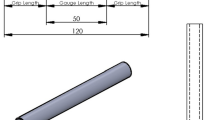Abstract
Wood-epoxy laminates were subjected to constant amplitude fatigue tests in tension-tension (R = 0.1), compression-compression (R = 10) and reverse loading (R = −1) in order to follow property changes and fatigue damage accumulation. Hysteresis loops were captured during these tests and the form of stress versus number of cycles to failure (S-N) curves was established. Reversed loading is the most damaging mode of cyclic stress application. In terms of static strengths, the wood laminate is weaker in compression than in tension. However at low levels of stress, following many fatigue cycles, the fatigue life is greater in compression-compression than in tension-tension. The shape of captured hysteresis loops is strongly influenced by loading mode. As subcritical damage develops, loop area increases and dynamic modulus falls. In reversed loading, loop bending and distortion is observed depending on whether the damage is tension- or compression-dominated or both. Maximum and minimum fatigue strains, the dynamic modulus and loop area have been plotted as a function of the number of fatigue cycles. The majority of damage occurs towards the end of the sample life but property changes can be detected throughout fatigue tests. Normalisation of fatigue data demonstrates that the fatigue behaviour of wood-epoxy laminates is consistent.
Similar content being viewed by others
References
M. P. Ansell, M. Hancock and P. W. Bonfield, in Proceedings of the 1991 International Timber Engineering Conference, London (TRADA, 1991) Vol. 4, p. 194.
P. W. Bonfield and M. P. Ansell, J. Mat. Sci. 26 (1991) 4765.
J. M. Dinwoodie, “Timber its Nature and Behaviour” (Van Nostrand Reinhold Co. Ltd., Workingham, UK, 1981).
K. T. Tsai and M. P. Ansell, J. Mat. Sci. 22 (1990) 865.
J. N. Yang L. J. Lee and D. Y. Sheu, Composite Structures 21 (1992) 91.
L. Ye, Composite Science and Technology 36 (1989) 339.
J. A. M. Ferreira, J. D. M. Costa, P. N. B. Reis and M. O. W. Richardson, Comp. Sci. and Tech. 59 (1999) 1461.
W. B. Hwang and K. S. Han, in “Composite Materials: Fatigue and Fracture,” Vol. 2, edited by P. A. Lagace (ASTM, Philadelphia, 1989) p. 87, ASTM STP102.
I. P. Bond and M. P. Ansell, J. Mat. Sci. 33 (1998) 2751.
Idem., ibid. 33 (1998) 4121.
Author information
Authors and Affiliations
Rights and permissions
About this article
Cite this article
Hacker, C.L., Ansell, M.P. Fatigue damage and hysteresis in wood-epoxy laminates. Journal of Materials Science 36, 609–621 (2001). https://doi.org/10.1023/A:1004812202540
Issue Date:
DOI: https://doi.org/10.1023/A:1004812202540




